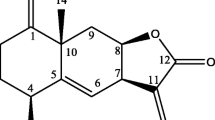Abstract
Amomum tsao-ko (A. tsao-ko) has been used as a traditional medicine for the treatment of infectious and digestive disorders. In the present study, we report the anti-inflammatory activity and molecular mechanism of 2,8-decadiene-1,10-diol (DDO) isolated from the extract of A. tsao-ko in lipopolysaccharide-stimulated RAW 264.7 cells. DDO treatment inhibited the production of nitric oxide and prostaglandin E2 by downregulating inducible nitric oxide synthase and cyclooxygenase-2 expression, respectively. Moreover, DDO suppressed the production of pro-inflammatory cytokines such as interleukin-6 and tumor necrosis factor-α. These inhibitory effects of DDO on the expression of inflammatory proteins were found to be mediated through the inactivation of mitogen-activated protein kinases (MAPKs) such as extracellular signal-regulated kinase, c-Jun-N-terminal kinase and p38MAPK, and inhibition of nuclear factor-κB (NF-κB) pathways including degradation of inhibitor of κB-α and nuclear localization of NF-κB. Taken together, these findings demonstrate the pharmacological roles and molecular mechanisms of DDO in regulating inflammatory responses, and suggest further evaluation and development of DDO as a potent therapeutic agent for the treatment of inflammatory disorders.






Similar content being viewed by others
References
Yang, Y., Y. Yue, Y. Runwei, and Z. Guolin. 2010. Cytotoxic, apoptotic and antioxidant activity of the essential oil of Amomum tsao-ko. Bioresource Technology 101: 4205–4211.
Moon, S.S., J.Y. Lee, and S.C. Cho. 2004. Isotsaokoin, an antifungal agent from Amomum tsao-ko. Journal of Natural Products 67: 889–891.
Yu, L., N. Shirai, H. Suzuki, N. Sugane, T. Hosono, Y. Nakajima, et al. 2010. The effect of methanol extracts of tsaoko (Amomum tsao-ko Crevost et Lemaire) on digestive enzyme and antioxidant activity in vitro, and plasma lipids and glucose and liver lipids in mice. Journal of Nutritional Science and Vitaminology 56: 171–176.
Li, B., H.J. Choi, D.S. Lee, H. Oh, Y.C. Kim, J.Y. Moon, et al. 2014. Amomum tsao-ko suppresses lipopolysaccharide-induced inflammatory responses in RAW264.7 macrophages via Nrf2-dependent heme oxygenase-1 expression. The American Journal of Chinese Medicine 42: 1229–1244.
Medzhitov, R. 2010. Inflammation 2010: new adventures of an old flame. Cell 140: 771–776.
Hayden, M.S., A.P. West, and S. Ghosh. 2006. NF-κB and the immune response. Oncogene 25: 6758–6780.
Lawrence, T. 2009. The nuclear factor NF-κB pathway in inflammation. Cold Spring Harbor Perspectives in Biology 1: a001651.
Ghosh, S., and M.S. Hayden. 2008. New regulators of NF-κB in inflammation. Nature Reviews Immunology 8: 837–848.
Barnes, P.J., and M. Karin. 1997. Nuclear factor-κB—a pivotal transcription factor in chronic inflammatory diseases. New England Journal of Medicine 336: 1066–1071.
Hotamisligil, G.S. 2006. Inflammation and metabolic disorders. Nature 444: 860–867.
Lumeng, C.N., and A.R. Saltiel. 2011. Inflammatory links between obesity and metabolic disease. The Journal of Clinical Investigation 121: 2111–2117.
Ben-Neriah, Y., and M. Karin. 2011. Inflammation meets cancer, with NF-κB as the matchmaker. Nature Immunology 12: 715–723.
Kaser, A., S. Zeissig, and R.S. Blumberg. 2010. Inflammatory bowel disease. Annual Review of Immunology 28: 573–621.
Lizzul, P.F., A. Aphale, R. Malaviya, Y. Sun, S. Masud, V. Dombrovskiy, et al. 2005. Differential expression of phosphorylated NF-κB//RelA in normal and psoriatic epidermis and downregulation of NF-κB in response to treatment with etanercept. Journal of Investigative Dermatology 124: 1275–1283.
Gillooly, K.M., M.A. Pattoli, T.L. Taylor, L. Chen, L. Cheng, K.R. Gregor, et al. 2009. Periodic, partial inhibition of IκB kinase β-mediated signaling yields therapeutic benefit in preclinical models of rheumatoid arthritis. Journal of Pharmacology and Experimental Therapeutics 331: 349–360.
Ahn, E.K., J.A. Lee, D.W. Seo, S.S. Hong, and J.S. Oh. 2012. 1β-Hydroxy-2-oxopomolic acid isolated from Agrimonia pilosa extract inhibits adipogenesis in 3T3-L1 cells. Biological and Pharmaceutical Bulletin 35: 643–649.
Ahn, E.K., and J.S. Oh. 2013. Lupenone isolated from Adenophora triphylla var. Japonica extract inhibits adipogenic differentiation through the downregulation of PPARγ in 3T3-L1 cells. Phytotherapy Research 27: 761–766.
Karin, M., and Y. Ben-Neriah. 2000. Phosphorylation meets ubiquitination: the control of NF-κB activity. Annual Review of Immunology 18: 621–663.
Vermeulen, L., G. De Wilde, P. Van Damme, W. Vanden Berghe, and G. Haegeman. 2003. Transcriptional activation of the NF-κB p65 subunit by mitogen- and stress-activated protein kinase-1 (MSK1). The EMBO Journal 22: 1313–1324.
Carter, A.B., K.L. Knudtson, M.M. Monick, and G.W. Hunninghake. 1999. The p38 mitogen-activated protein kinase is required for NF-κB-dependent gene expression: the role of TATA-binding protein (TBP). Journal of Biological Chemistry 274: 30858–30863.
Kim, H.J., H.S. Lee, Y.H. Chong, and J.L. Kang. 2006. p38 mitogen-activated protein kinase up-regulates LPS-induced NF-κB activation in the development of lung injury and RAW 264.7 macrophages. Toxicology 225: 36–47.
Zandi, E., D.M. Rothwarf, M. Delhase, M. Hayakawa, and M. Karin. 1997. The IκB kinase complex (IKK) contains two kinase subunits, IKKα and IKKβ, necessary for IκB phosphorylation and NF-κB activation. Cell 91: 243–252.
Delhase, M., M. Hayakawa, Y. Chen, and M. Karin. 1999. Positive and negative regulation of IκB kinase activity through IKKβ subunit phosphorylation. Science 284: 309–313.
Guha, M., and N. Mackman. 2001. LPS induction of gene expression in human monocytes. Cellular Signalling 13: 85–94.
Bode, J.G., C. Ehlting, and D. Häussinger. 2012. The macrophage response towards LPS and its control through the p38MAPK–STAT3 axis. Cellular Signalling 24: 1185–1194.
Hommes, D.W., M.P. Peppelenbosch, and S.J.H. van Deventer. 2003. Mitogen activated protein (MAP) kinase signal transduction pathways and novel anti-inflammatory targets. Gut 52: 144–151.
Karin, M. 2006. Nuclear factor-κB in cancer development and progression. Nature 441: 431–436.
Acknowledgments
This study was supported by the research fund of Dankook University in 2015.
Author information
Authors and Affiliations
Corresponding author
Ethics declarations
Conflict of Interest
The authors declare that they have no competing interests.
Additional information
Mi-Sun Kim and Eun-Kyung Ahn contributed equally to this work.
Rights and permissions
About this article
Cite this article
Kim, MS., Ahn, EK., Hong, S.S. et al. 2,8-Decadiene-1,10-Diol Inhibits Lipopolysaccharide-Induced Inflammatory Responses Through Inactivation of Mitogen-Activated Protein Kinase and Nuclear Factor-κB Signaling Pathway. Inflammation 39, 583–591 (2016). https://doi.org/10.1007/s10753-015-0283-1
Published:
Issue Date:
DOI: https://doi.org/10.1007/s10753-015-0283-1




